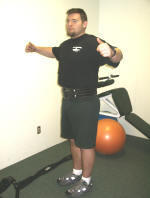|
back
Strength Training
Strength training is the cornerstone of a healthy back
and a healthy body. It can help to
- accelerate weight loss
- reduce back pain
- prevent injury
- reduce osteoporosis
Weight loss: it is well known that muscle
burns more calories than fat does. A body which is lean (low in fat
relative to muscle) will burn calories more efficiently. Body builders
are very familiar with this concept. When they are "off season" and
trying to get stronger and bulk up, they eat a large amount of calories, and
don't do cardiovascular activities. Then, 12 weeks before a
competition, they decrease their caloric intake, and start doing
cardiovascular activities. They dramatically lose weight, and with
what appears to be great ease. This is because their bodies are such
efficient machines at burning calories, that the small reduction in caloric
intake through a change in diet, combined with the increased caloric burn
through cardiovascular activity, allows a quick reduction in body fat.
We find that people often significantly underestimate
the value of strength training in weight loss. DO NOT UNDERESTIMATE
THE VALUE OF STRENGTH TRAINING.
Back pain reduction; injury prevention: a
stronger back is naturally more resistant to injury; the muscles are
stronger, the ligaments stronger, and the tendons stronger. While
cardiovascular activities deliver more oxygen to the muscles, only strength
training can really hypertrophy (thicken) muscle cells. Stronger
muscles, tendons and ligaments provide for better posture and better support
of the spine, and reduce pain.
Osteoporosis: the weakening of bone which is common as
the aging process progresses, has been shown to be significantly slowed or
stopped by strength training. Wolff's law tells us that constant
stress upon bone actually causes the bone to grow stronger. Bone
density have been shown to change even in the short time astronauts are in a
weightless environment. Similarly, strength training can cause the
bones to become stronger.
Strength Training
It would be nice if there were a certain set of
exercises which one could do to develop a strong back, to reduce back pain,
and concentrate upon those, without working the rest of the body. We
would like to tell you this were the case, but it isn't. There are
exercises which work the back, but to do these without strengthening the
rest of the body is pointless.
Would you put a V10 engine in a car without
improving the tires and suspension system? No!
Would you put on a finely tailored suit, and wear
sneakers and tube socks? No!
Would you build a house with a strong sturdy iron
frame, to be built upon a weak foundation? No!
Would you strengthen your back, without
strengthening the foundation upon which it is built? No!
Sometimes low back pain is caused by
reasons other than your low back. Weak abdominal (stomach muscles) or weak
hamstrings (back of leg) could also cause low back problems. Weak trapezoids
may cause low back problems by causing the shoulders to slouch, which
causes poor posture and added stress to the lower back. Musculature
imbalances like these may cause your posture to go bad and put the stress on
your lower back. We recommend a total body workout with an extra emphasis on
problem areas.
All the body parts must be strengthened in a
deliberate, methodical manner. After beginning the program, and
understanding the principles of strength training, you will agree!!
One last thing before you lift !!
Many individuals will wear a weight
lifting belt to help support there lower back during total body workouts. This
is okay to do as long as you do not become totally reliant upon it. Also, a belt
should not be worn during lower back and abdominal exercises.
There are many different
 kinds of weight lifting belts on
the market today. Many belts have a large area on the back for support but a
small frontal area of support. This is not a proper weight lifting belt.
It may actually cause one to lean forward causing bad posture and putting to
much stress on the lower back region. kinds of weight lifting belts on
the market today. Many belts have a large area on the back for support but a
small frontal area of support. This is not a proper weight lifting belt.
It may actually cause one to lean forward causing bad posture and putting to
much stress on the lower back region.
A proper belt should be the same size in
the back as it is in the front. 
Also an individual that
has been wearing a belt during their exercises and suddenly does not wear it
 and
tries to lift the same amount of weight may injure there lower back. So if you
forget your belt when you go to the gym then lift light. and
tries to lift the same amount of weight may injure there lower back. So if you
forget your belt when you go to the gym then lift light.
|

